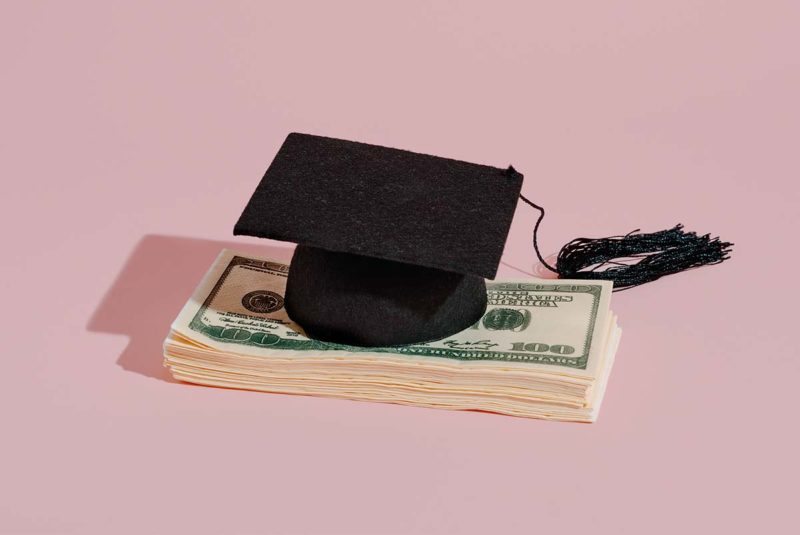Facing a student loan default can be intimidating. Especially when terms like collections agencies, lawsuits and wage garnishment are thrown around in the same sentence (like this one). And while it is serious, it’s not the end of the world.
If your student loans are in default, you’re not alone. Education Data Initiative reports that 25% of federal student aid borrowers go into loan default within their first five years of repayment.[2]
Student loan default happens when the borrower has missed the payments due for an extended period of time. Whether the loan defaults depends on the type of loan and terms agreed upon when the borrower took it out.
Whether you just want to learn more, or you’re currently facing default, we’re here to help. In this article, we’ll go over what a student loan default means, how to avoid it and how to recover.
What Happens If You Default on Student Loans?
Many factors come into play when someone defaults on either their private or federal student loans. The consequences of defaulting on your loans are numerous and can especially have a negative impact on your credit score.
Here are some of the ways student loan default can affect you, though some are specific to federal or private loan default. Or, as we call it, a long list of reasons to avoid default!
- Acceleration: The entire loan balance, including interest, becomes immediately due.
- Collections: A collections agency might aggressively reach out to collect the past-due balance.
- Loss of loan perks: You cannot apply for forbearance or a deferral (types of pauses on payments) or qualify for federal loan forgiveness programs.
- Wage garnishment: Your wages may be garnished and applied to the debt, meaning the ED can tell an employer to take up to 15% of your pre-tax wages after you miss 9 months of payments.[3]
- Government income withheld: Your tax return or Social Security payments may be garnished and applied to the debt.
- Lower credit score: After 90 days, your lender can report your default to the three credit bureaus, which will lower your credit score.
- Lawsuit: Your lender can take you to court to sue for the entire loan balance and you can be held liable for lawyer or other court fees.
- Blocked sales: You may not be able to buy or sell assets like real estate.
- Career consequences: You might be denied trying to get or renew any professional license you hold or trying to enlist in the Armed Forces.
But if you’ve only missed one payment, don’t stress. It happens all the time, and you’re not automatically in default. The step between healthy loans and defaulted loans is called delinquency, and it’s kind of like a warning period. Let’s quickly define the differences.
Delinquent loan vs. default
Delinquency and default are both the results of missing payments, with default being more serious. Think of delinquency as a red flag. Something’s wrong, you’ve missed a payment. Better to fix it early before you get in too deep and actually default.
Your loans are usually marked as delinquent after a single missed loan payment. Meanwhile, getting labeled as defaulted means you’ve missed multiple payments or otherwise strayed from the loan terms you originally agreed to.
In most cases, you can fix delinquency easily by paying the missed payment and any resulting fees.
Default takes considerably longer to remedy, often requiring a strict and consistent repayment schedule over a set period of time.
It’s not all doom and gloom. We’ll talk about how to get help for either situation a bit later. But first, we’ve outlined some of the differences between defaulted federal and private student loans.
Federal loan default
Defaulting on a federal loan means breaking the terms laid out in the Master Promissory Note, which you would’ve signed when you accepted the loan.
Federal student loan default differs depending on the loan type. Most loan types follow the same rules, but the retired Perkins loan program operates a little differently.
- It takes 270 days of missed payments to cause federal direct subsidized, unsubsidized loans or PLUS loans to default.[4]
- A single missed payment causes Perkins loans to default.[4]
While federal loan default generally results in acceleration, you currently have until August 31, 2023 to worry about your entire balance being due, under the latest extension of the CARES Act[1]
So, you see why now is the time to rehabilitate your defaulted loans. In a section coming up, we’ll show you three distinct ways to recover your federal student loan.
Private loan default
Private loan default operates a little differently than federal loan default, but the severity of it is similar. It still comes down to breaking the terms you agreed upon in the Promissory Note you signed when you accepted the loan. But the terms are different from federal loans.
Private loans generally go into default after three missed payments, or 120 days. However, because they’re through private lenders, that’s not always the case. Some can go into default as soon as one missed payment. So it’s important to read the terms of your private loan carefully.
Again, there are options to rehabilitate your private student loans. However, they can be more complicated than the options available for federal student loans.
How Do I Get My Student Loans Out of Default?
Don’t wait to tackle your defaulted loans. Instead, start fixing them as soon as possible. There are a few ways you can rehabilitate a defaulted student loan, depending on whether it’s federal or private. Just know upfront that fixing a default for both loan types requires patience and consistency.
Recovering federal student loans
The U.S. Department of Education (ED) provides three ways to get out of federal student loan default. Each may present unique challenges, but all will ultimately help you clean up your loans.
- Loan rehabilitation: You promise (and follow through) to make nine, on-time payments within 10 months. The payments don’t have to be the same amount your payments have been in the past. The ED will evaluate your situation and assign you an income-based payment for the rehabilitation term. It’s important to note that this is a one-time option. If the same loan goes into default again, you can’t rehabilitate it.[5]
- Loan consolidation: If you can make three, on-time payments, you have the option to apply for a direct consolidation loan that combines multiple federal loans into a single loan. Consolidating with an income-driven repayment plan wipes out your defaulted status and can help make your payments more manageable. New payments are usually between 10% and 20% of your discretionary income.[5]
- Loan repayment: Your third option is simply to repay the entire balance of the loan. While this option doesn’t fix your loan, it does save you from some of the legal and practical complications of having a loan in default.
Recovering private student loans
Private student loan default can be a little trickier to get out of, especially since there’s no consistent program and each lender can have their own requirements. However, there are a few strategies that can help.
- Reach out to your lender and ask them if they have a loan rehabilitation program.
- Explain your situation and ask if your lender can help you get your payments up to date.
- If they’ve started collections, see if you can reach a settlement on your debt.
- Work with a lawyer who specializes in student loans and can help you navigate the process.
Avoid Getting a “D” on Your Student Loans – You Have Better Options
If you’re wondering how to find additional student loan help, consider applying for forbearance or a deferral, or consider other loan repayment options. You may also be eligible for an income-driven repayment plan that could lower your monthly payment significantly.
You may not be in school anymore, but the idea of getting a “D” for delinquent should still give you pause before you go into default. Just like when you were in school, though, there are resources available to help you restore your loan status and get you back on track.
The Short Version
- Student loan default happens when the borrower has missed the payments due for an extended period of time
- The consequences of defaulting on your loans are numerous and can have a negative impact on your credit score
- While federal loan default generally results in acceleration, you have until August 2022 to worry about your entire balance being due, under the CARES Act[1]
U.S. Department of Education. “COVID-19 Emergency Relief and Federal Student Aid. Retrieved January 2023 from https://studentaid.gov/announcements-events/covid-19
Education Data Initiative. “Student Loan Default Rate.” Retrieved March 2022 from https://educationdata.org/student-loan-default-rate
Federal Student Aid. “What is wage garnishment?” Retrieved March 2022 from https://studentaid.gov/help-center/answers/article/what-is-wage-garnishment
Federal Student Aid. “Student Loan Delinquency and Default.” Retrieved March 2022 from https://studentaid.gov/manage-loans/default
Federal Student Aid. “Getting Out of Default.” Retrieved March 2022 from https://studentaid.gov/manage-loans/default/get-out




